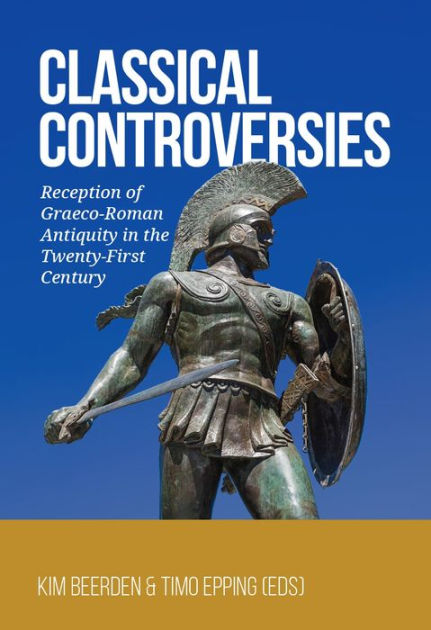Review of 'Classical Controversies'

Review of Kim Beerden and Timo Epping (eds) Classical Controversies: Reception of Greco-Roman Antiquity in the Twenty-First Century (Leiden: Sidestone Press, 2022), Journal of Anthropological Research 80 (1), Spring 2024, 98-9.
Classics, as a discipline, has often been bedevilled in recent times by the need to assert its ‘relevance’ to the modern world. This timely and thought-provoking collection of essays demonstrates that the stakes of such ‘relevance’ can be all too high when the contemporary appropriations of antiquity in question often fuel extreme right-wing political agendas. The ‘controversies’ of the volume’s title are subdivided into two main sections, dealing respectively with politicised appeals to the ancient world (with a particular focus on Sparta and the far right in recent American, Scandinavian, and German politics) and problems in contemporary heritage ethics, centred around the Dutch National Museum of Antiquities (RMO) in Leiden.
Two introductory essays, by Kim Beerden and Frederick G. Naerebout respectively, frame the collection in activist terms, with the latter’s manifesto for ‘stop[ping] the steal’ of Classics by political extremists even suggesting that Greco-Roman culture should be torn from its pedestal and that an interconnected and transchronological ‘global antiquity’ should be taught at universities instead (a shame, perhaps, that these recommendations could not have been more extensively fleshed out and theoretically underpinned?). Beerden’s preface, meanwhile, represents one of the volume’s more valuable contributions, in that it stresses the ideological nature of any engagement with antiquity, alongside a rousing call to action: scholars in the field should not shy away from becoming involved in and commenting on current affairs and debates, whilst simultaneously contributing in positive fashion to the ways in which society perceives their discipline.
In one sense, the volume encapsulates some of the advantages and pitfalls of contemporary classical reception in parvo. For instance, some of the articles in Part II (Controversies and Literary Traditions) appear problematically under-theorised in terms of the methodology of using the internet as a source or engaging with meme culture, or simply make an argument based on a handful of not necessarily representative examples, without paying due attention to the dynamic interplay of text and context. Such omissions are especially surprising given that classicists’ attitudes to the ancient sources would surely never have been so slapdash.
Of the three essays which present Spartan reception as a form of case study (though this is never explicitly stated), Julia Müller’s chapter stands out for its originality and coherence in analysing the use of Spartan imagery and propaganda in the far-right Identitarian movement in France and Germany. Drawing more on visual motifs and the film 300 than on any engagement with ancient sources, the Identitäre Bewegung Deutschland use the lambda symbol as a less tainted substitute for more traditional neo-Nazi symbols such as the swastika or the black sun, decorating everything from masks and cigarette lighters to fake shields during their performative ‘neo-Spartan’ cosplay at political demonstrations.
Other chapters of interest include Marco Gay’s analysis of the trope of ‘Aeneas as asylum-seeker’ in current Italian debates on the migrant crisis, and Barbara Holler’s analysis of depictions of classicists in contemporary fiction, which tend to perpetuate “stale, pale, male” stereotypes about the discipline. She suggests that more inclusive characterisations in fiction might contribute to shifting unhelpful perceptions and making Classics more welcoming to a diverse cross-section of society.
The essays in Section III, on controversies in museums and heritage ethics, feel somewhat less heterogeneous, and contain some very thought-provoking reflections on the presentation of death, queering museum collections and museological praxis, and the problematic deployment of inherently Orientalising colonialist stereotypes in a popular Dutch children’s book series, Dummie de Mummie, which was later co-opted into museum outreach programmes for younger visitors at the RMO. Patricia Kret’s article on Graeco-Roman death in contemporary museum display can be singled out here for its detailed analysis of approaches to death in a range of museal settings, from permanent collections to more temporary experimental exhibitions which allow for greater focus on rituals and individual stories, as well as for its suggestions of ways in which mortuary artefacts and even human remains can be presented sensitively yet creatively, without necessarily having to be subordinated to dominant cultural frameworks.
Overall, although the coherence of the collection or its representativeness could be questioned, such niggles are often apparent when dealing with a volume originating from a specific conference. The editors have nevertheless done a valuable job in highlighting some of the more problematic – and indeed controversial – aspects of contemporary classical reception, and the volume certainly offers ample food for thought, as well as providing a useful springboard for future research.
